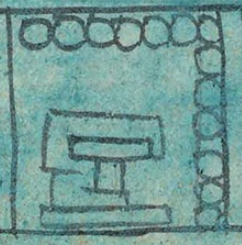Matlactli Omei Calli (Mdz2r)
This simplex glyph plus notation represents the solar year (xihuitl) Thirteen House (Matlactli Omei Calli), also written 13-House. It includes a house or building (calli) and a notation consisting of thirteen small circles, providing the number. Sometimes the ones are grouped as though being counted on hands and toes, but this group of ones all runs together. Of course, thirteen are as many as are possible in the calendar, and any more would be a challenge to fit. The building is the standard rectangular sign with T-shaped wooden beams in an orange color and the rest being white. It is shown in a profile view, facing toward the viewer's right. The whole compound is painted over with the color of turquoise blue, which calls to mind the word for both year and turquoise (xihuitl).
Stephanie Wood
A boxed-in date says this refers to a year. The turquoise wash over the date is a visual reminder that these are dates, given that green and blue-green (xihuitl) is a homophone with the word for year (xihuitl). The paint might therefore be interpreted as a phonetic indicator for the word "year." The Matlactli Omei Acatl (Thirteen Reed or 13-reed) glyph, below, shows another way of grouping the 13 ones, shown as 5 + 3 + 5.
Stephanie Wood
c. 1541, or by 1553 at the latest
Stephanie Wood
números, edificios, casas, fechas, calendario, xiuhpohualli, año, turquesa, xihuitl, mahtlactli, nombres de años

matlacli mmei, thirteen, https://nahuatl.wired-humanities.org/content/matlactli-omei
calli, house, https://nahuatl.wired-humanities.org/content/calli
Trece Casa
Stephanie Wood
Codex Mendoza, folio 02 recto, https://digital.bodleian.ox.ac.uk/objects/2fea788e-2aa2-4f08-b6d9-648c00..., image 14 of 188.
The Bodleian Libraries, University of Oxford, hold the original manuscript, the MS. Arch. Selden. A. 1. This image is published here under the UK Creative Commons, “Attribution-NonCommercial-ShareAlike 3.0 License” (CC-BY-NC-SA 3.0).

